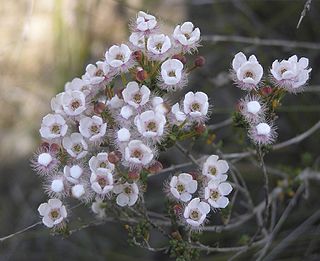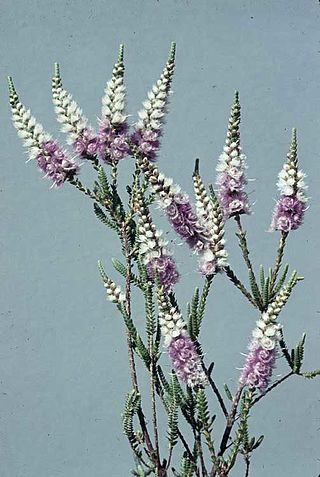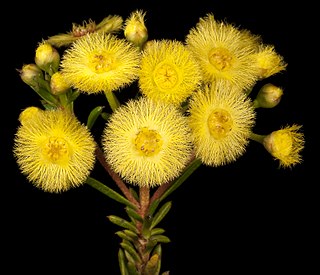Verticordia forrestii, commonly known as Forrest's featherflower, is a flowering plant in the myrtle family, Myrtaceae and is endemic to the north-west of Western Australia. It is a shrub with small, egg-shaped leaves and massed displays of scented pink to red flowers in spring.

Verticordia plumosa, commonly known as plumed featherflower, is a flowering plant in the myrtle family, Myrtaceae and is endemic to the south-west of Western Australia. It was the first species in the genus to be described, although initially given the name Chamelaucium plumosum. It is a shrub with linear leaves and rounded groups of scented pink, mauve or white flowers. Two varieties of this species have been declared as being "threatened".

Verticordia verticillata, commonly known as tropical featherflower or whorled-leaved featherflower is a flowering plant in the myrtle family, Myrtaceae and is endemic to an area in the north of the Northern Territory and Western Australia. It is a woody shrub or small tree with relatively long, linear leaves arranged in whorls, and with irregular groups of creamy-white flowers in spring.
Verticordia patens is a flowering plant in the myrtle family, Myrtaceae and is endemic to the south-west of Western Australia. It is a shrub with linear, pointed leaves and faintly scented, pale yellow flowers in open heads on the ends of the branches. It is fairly common in a small area south of Badgingarra.

Verticordia habrantha, commonly known as hidden featherflower, is a flowering plant in the myrtle family, Myrtaceae and is endemic to the south-west of Western Australia. It is a slender shrub with short, leafy side-branches and long flowering stems with rounded heads of mostly white flowers. Its hairy sepals are mostly hidden by the round, unfringed petals, and as a result, the plant looks like shrubs in the genus Chamelaucium, to which it is closely related.

Verticordia halophila, commonly known as salt-loving featherflower, or salt-loving verticordia, is a flowering plant in the myrtle family, Myrtaceae and is endemic to the south-west of Western Australia. It is an erect, bushy shrub with small, crowded, thick leaves and spikes of red and pink flowers in spring.

Verticordia helichrysantha, commonly known as coast featherflower or Barrens featherflower, is a flowering plant in the myrtle family, Myrtaceae and is endemic to the south-west of Western Australia. It is a small, woody, open-branched shrub with crowded, linear leaves and small yellow flowers from May to September.

Verticordia spicata, commonly known as spiked featherflower, is a flowering plant in the myrtle family, Myrtaceae and is endemic to the south-west of Western Australia. It is usually a dense, bushy shrub with small leaves pressed against the stem and spikes of pink flowers from late spring to early summer.

Verticordia pritzelii, commonly known as Pritzel's featherflower, is a flowering plant in the myrtle family, Myrtaceae and is endemic to the south-west of Western Australia. It is a compact, woody shrub with several main stems, small, linear to club-shaped leaves, and rounded groups of deep pink flowers from late spring to mid-summer.

Verticordia galeata is a flowering plant in the myrtle family, Myrtaceae and is endemic to the south-west of Western Australia. It is a woody shrub with thin, pointed cylinder-shaped leaves and heads of bright yellow flowers on the ends of the branches in spring.

Verticordia staminosa is a flowering plant in the myrtle family, Myrtaceae and is endemic to the south-west of Western Australia. It is a shrub comprising two subspecies, one of which has two varieties. All three types have a limited distribution and have been classified as "Threatened". It is distinguished from other species of verticordia by its prominent, long stamens which extend well beyond its feathery yellow sepals and petals.

Verticordia chrysantha, commonly known as yellow featherflower or yellow Morrison, is a flowering plant in the myrtle family, Myrtaceae and is endemic to Western Australia. It is a small, slow-growing, rather bushy shrub with bright yellow flowers which often turn reddish-brown as they age. It is widespread in the south-west of the state.
Verticordia endlicheriana var. endlicherliana is a flowering plant in the myrtle family, Myrtaceae and is endemic to the south-west of Western Australia. It is a small, compact shrub with mostly narrow leaves and golden-yellow flowers which age to reddish brown.
Verticordia endlicheriana var. compacta is a flowering plant in the myrtle family, Myrtaceae and is endemic to the south-west of Western Australia. It is a small, usually compact shrub with sweetly-perfumed, golden-yellow flowers which fade through reddish to almost black as they age.
Verticordia endlicheriana var. major is a flowering plant in the myrtle family, Myrtaceae and is endemic to the south-west of Western Australia. It is a small, compact shrub with lightly-scented, lemon-yellow flowers which do not change colour as they age.

Verticordia nobilis, commonly known as northern grandiflora, is a flowering plant in the myrtle family, Myrtaceae and is endemic to the south-west of Western Australia. It is an openly branched shrub with linear leaves and groups of scented, yellow flowers which turn deep red as they age.

Verticordia ovalifolia, commonly known as oval-leaved featherflower, is a flowering plant in the myrtle family, Myrtaceae and is endemic to the south-west of Western Australia. It is an openly branched shrub with egg-shaped leaves and strap-like, feathery petals in spring.

Verticordia oxylepis, commonly known as bonsai featherflower, is a flowering plant in the myrtle family, Myrtaceae and is endemic to the south-west of Western Australia. It is a small shrub, often with a layered appearance, small leaves and very small yellow and pink flowers.

Verticordia rutilastra, commonly known as little grandiflora, is a flowering plant in the myrtle family Myrtaceae and is endemic to Southwest Australia, a biodiversity hotspot in Western Australia. It is a small shrub with short upper branches, narrow leaves and yellow, feathery flowers, often with a star-like red centre.

Verticordia tumida, commonly known as summer featherflower, is a flowering plant in the myrtle family, Myrtaceae and is endemic to the north-west of Western Australia. It is an open shrub with very small leaves and clusters of deep pink flowers from late spring to early winter.
















